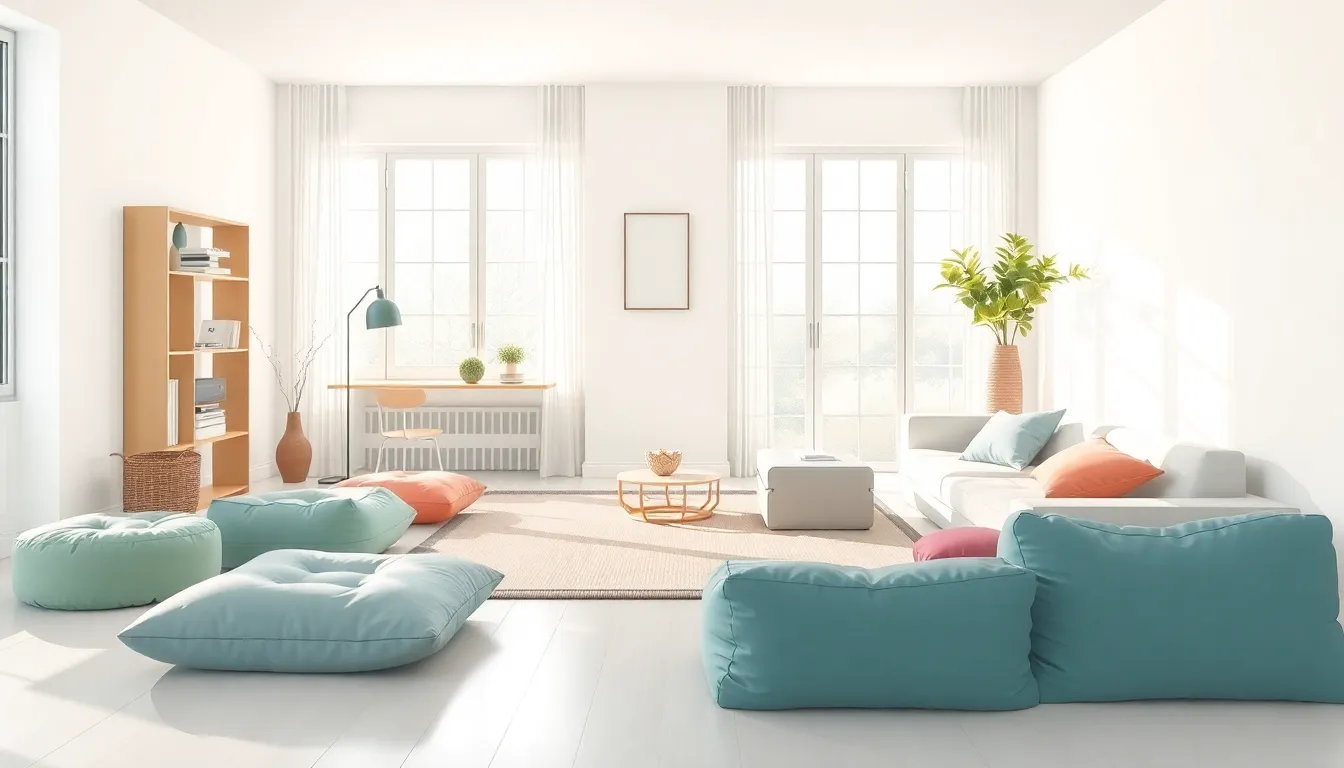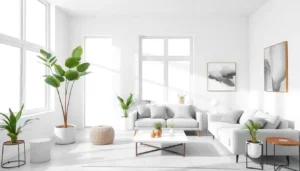Table of Contents
ToggleImagine walking into a living room that feels as light as a feather and as spacious as a cloud. No bulky sofa hogging the space. Instead, it’s a fresh canvas where creativity flourishes and relaxation reigns supreme. Minimalist living rooms without sofas are not just a trend; they’re a lifestyle choice that invites simplicity and elegance into everyday life.
Ditching the sofa might sound radical, but this approach opens up endless possibilities. Think floor cushions that double as art pieces or sleek benches that invite spontaneous gatherings. With the right touches, a sofa-less living room can become a sanctuary of style and comfort. So why not embrace the freedom of minimalism? It’s time to transform that living space into a haven where less truly means more.
Understanding Minimalist Living Room Design
Minimalist living room design focuses on simplicity and functionality. It prioritizes open spaces and essential elements.
Key Principles of Minimalism
Clarity defines minimalist design. A clear layout reduces visual clutter, promoting a sense of calm. Functionality becomes critical; each piece in the space should serve a purpose. Natural light plays a significant role, as it enhances the atmosphere. Neutral color palettes and textures create harmony. Creative storage solutions like built-in shelves efficiently maximize space without sacrificing style.
Benefits of a Minimalist Living Room
Simplicity fosters tranquility in a minimalist living room. The absence of unnecessary items decreases stress, leading to a peaceful environment. Versatility increases; furniture like floor cushions adapts to various activities. A minimalist space is easier to maintain, saving time on cleaning. Cost-effectiveness is another benefit, as fewer furnishings typically reduce initial buying expenses. Lastly, a well-curated space showcases personal style, inviting unique expression without overwhelming clutter.
Alternatives to Traditional Sofas

Exploring alternatives to traditional sofas enhances minimalist living rooms. These options add comfort and style without clutter.
Floor Seating Options
Floor seating options create a relaxed atmosphere. Cushions and poufs come in various styles, offering versatility. Large floor cushions provide ample space for lounging, while low-profile seating maintains an airy feel. Tatami mats or area rugs work well to define seating areas and add softness. In addition, these elements promote social interactions, creating an inviting environment.
Multi-Functional Furniture
Multi-functional furniture maximizes space in minimalist living rooms. Ottomans can serve as seating and storage solutions. Convertible benches provide flexible arrangements for guests. Nesting tables offer surface area when needed while saving space when not in use. Incorporating these pieces fosters a dynamic yet organized setting, blending functionality with minimalist aesthetics.
Choosing the Right Decor
Selecting the right decor transforms a minimalist living room into a stylish yet functional space. Thoughtful choices enhance the overall aesthetic while promoting simplicity.
Color Palettes for Minimalist Spaces
Neutral color palettes create a serene atmosphere in minimalist spaces. Shades like white, beige, and soft gray work well together, providing a calming backdrop. Incorporating earth tones adds warmth, while subtle pastels can introduce moments of interest. These colors reflect light, making rooms feel larger and brighter. Consider using a single accent color to add depth without overwhelming the design. Consistency across different decor elements maintains harmony, ensuring the space remains visually appealing.
Selecting Minimalist Accessories
Choosing accessories carefully ensures they align with the minimalist design ethos. Opt for functional pieces that serve a purpose, like stylish storage solutions or well-designed lighting. Select a few statement items that speak to personal style, such as abstract art or minimalist sculptures. Textural variety enhances visual interest; consider incorporating a soft throw or textured pillows. Avoid overcrowding surfaces; prioritize open spaces to maintain a feeling of airiness. Well-placed accessories complement the overall design while reflecting individuality.
Creating a Cozy Atmosphere
A cozy atmosphere enhances the minimalist living room experience, inviting relaxation and warmth. Thoughtful elements contribute to this ambiance.
Lighting Solutions
Lighting sets the mood in a sofa-less living room. Natural light from windows adds a bright and airy feel. Layered lighting creates depth: utilize floor lamps and wall sconces to highlight specific areas. Dimmable fixtures offer versatility, allowing adjustments for day or night. Soft, warm bulbs create a welcoming environment, making the space feel intimate. Incorporating candles or LED options can add a touch of flickering charm.
Textures and Materials
Textures enrich a minimalist living room’s aesthetic. Mixing materials like wood, metal, and soft fabrics maintains visual interest while promoting comfort. Rugs can ground the space, providing warmth underfoot and enhancing acoustics. Linen, cotton, and wool add softness, while sleek metal or glass elements contribute a modern touch. Layering these textures creates a multi-dimensional feel, inviting tactile experiences in a compact setting. Thoughtful choices elevate functionality while remaining true to minimalism.
Maximizing Space Efficiency
Maximizing space efficiency in a minimalist living room fosters an organized and airy atmosphere. Emphasizing functional design and smart arrangements elevates the overall experience.
Organizational Strategies
Effective organization transforms any living room. Utilize vertical storage solutions like wall shelves or cabinets, which create additional space while keeping essentials accessible. Consider using baskets and bins to store items neatly while maintaining easy access. Layout plays a vital role; place furniture close to walls to maximize walking space in the center. Choose multipurpose furniture, such as benches with under-seat storage, which offer flexibility and practicality. Implementing these strategies encourages a seamless flow and maintains a minimalist aesthetic.
Decluttering Tips
Decluttering remains crucial in achieving a minimalist living area. Start by sorting belongings into categories: keep, donate, or discard. This simplification process removes unnecessary items and focuses on essentials. Establish a routine for regular assessment of items, ensuring that everything serves a purpose or brings joy. Additionally, implement the “one in, one out” rule to prevent accumulation of new items. Adopting these decluttering practices cultivates a serene environment that aligns with minimalist principles, enhancing both comfort and functionality.
Embracing a minimalist living room without a sofa opens up a world of creative possibilities. It encourages individuals to rethink traditional layouts and explore innovative seating options that enhance both comfort and style. By focusing on simplicity and functionality, a sofa-less space can become a serene retreat that reflects personal taste.
Thoughtful decor choices and strategic arrangements contribute to a harmonious atmosphere. The balance of textures and colors creates visual interest while maintaining a sense of calm. Ultimately, a minimalist approach fosters a lifestyle that values quality over quantity, allowing for a more meaningful and organized living experience.










